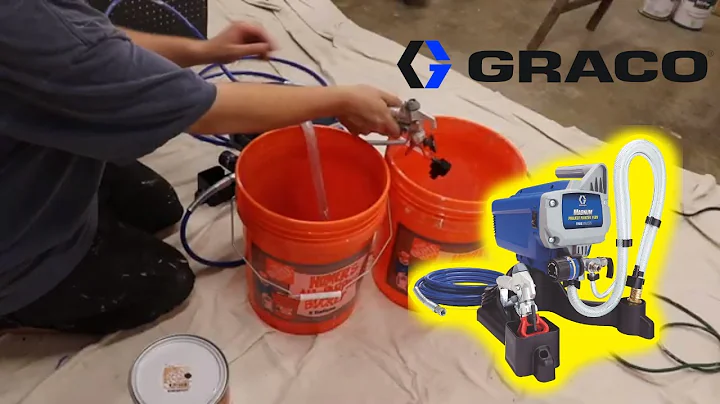Maximize Performance and Prevent Repairs: Adjusting Track Tension on Ski-Doo Snowmobile
Table of Contents
- Adjusting Track Tension on your Ski-Doo Snowmobile
- Importance of Track Tension Adjustment
- Maximizing sled performance
- Preventing potential repairs
- Tools required for Track Tension Adjustment
- Tensiometer
- Track stand
- Wrenches and screwdriver
- Step-by-step Guide to Adjust Track Tension
- Lift the rear of the sled off the ground
- Set the tensiometer to the proper settings
- Check track deflection and tighten if needed
- Ensure proper track alignment
- Checking Track Alignment
- Final Steps and Precautions
- Re-tightening the rear axle nut
- Replacing rear idler wheel covers
- Additional Tips for Ski-Doo Snowmobile Owners
- Regular maintenance
- Accessing owner's section on Ski-Doo website
- Conclusion
- Resources
Adjusting Track Tension on your Ski-Doo Snowmobile
🛠️ Tools required: Tensiometer, track stand, wrenches, screwdriver
One of the essential maintenance tasks for Ski-Doo snowmobile owners is adjusting the track tension. The track, which is under significant stress, tends to stretch during the initial break-in period. Proper adjustment of the track tension ensures optimal performance and prevents potential repairs in the future. In this article, we will guide you through the process of adjusting the track tension on your Ski-Doo snowmobile step-by-step.
Importance of Track Tension Adjustment
✅ Maximizing sled performance
By maintaining the track tension within the recommended specifications, you can maximize your sled's performance throughout the season. Proper track tension allows for better traction, improved handling, and increased speed, enhancing your overall snowmobiling experience.
❌ Preventing potential repairs
Neglecting to adjust the track tension can lead to various issues such as excessive wear, track slippage, and damage to components. By regularly checking and adjusting the track tension, you can prevent costly repairs and ensure the longevity of your snowmobile.
Tools required for Track Tension Adjustment
Before starting the track tension adjustment process, gather the following tools: a tensiometer, track stand, 17-millimeter wrench or socket wrench, 10-millimeter wrench, and a flathead screwdriver. These tools are commonly found in most garages and are essential for a smooth adjustment process.
Step-by-step Guide to Adjust Track Tension
-
Lift the rear of the sled off the ground using a track stand or a ceiling-mounted hoist. It is crucial to ensure that the entire track hovers in the air for a precise adjustment.
-
Set your tensiometer to the recommended settings specified in your Ski-Doo snowmobile operator's guide. The settings may vary depending on the model and year of your snowmobile.
-
Position the tensiometer on the track edge between the front and rear idler wheels. Press down until you get a reading. If the track deflection exceeds the specifications in your operator's guide, it needs tightening.
-
To tighten the track deflection, remove the rear idler wheel caps using a flathead screwdriver. Loosen the screw or nut with a socket wrench and tighten the adjustment screws evenly on both sides of the rail using a socket or wrench. It is crucial to maintain proper track alignment by evenly tightening the screws.
-
Continuously tighten the adjustment screws in small increments until the desired track tension is achieved.
Checking Track Alignment
Proper track alignment is essential for smooth operation and even wear of the track. After adjusting the track tension, it is crucial to check the track alignment.
-
Ensure that everything is clear of the track before starting the sled. Start the sled and slowly rotate the track for about 15 to 20 seconds.
-
Check if the track clips on each side are equally distant from the edge of the rail. If the track is not aligned, loosen the rear axle fastener and adjust the alignment bolt accordingly. Repeat this step, making small adjustments until the track is fully aligned.
Final Steps and Precautions
After aligning the track and achieving the desired tension, complete the process with the following steps:
-
Re-tighten the rear axle nut or screw to the torque specifications outlined in your operator's guide. This ensures the secure attachment of the track components.
-
Replace the rear idler wheel covers to protect the internal components from debris and damage during snowmobiling.
Remember to perform regular maintenance and check track tension periodically to maintain your Ski-Doo snowmobile's optimal performance and prolong its lifespan.
Additional Tips for Ski-Doo Snowmobile Owners
- Follow the maintenance schedule outlined in your operator's guide to ensure your snowmobile's longevity and reliable performance.
- Explore the owner's section on the Ski-Doo website for additional resources, guides, and tips for maintaining and enjoying your snowmobile to the fullest.
Conclusion
Adjusting the track tension on your Ski-Doo snowmobile is a crucial maintenance task that ensures optimal performance, extends the lifespan of your snowmobile, and helps you avoid potential repairs. By following the step-by-step guide provided in this article and performing regular maintenance, you can enjoy safe and thrilling snowmobiling adventures for years to come.
Resources
Highlights
- Adjusting track tension maximizes sled performance and prevents potential repairs.
- Proper tools, such as a tensiometer and track stand, are essential for track tension adjustment.
- Step-by-step guide to adjust track tension, including checking alignment.
- Regular maintenance and checking track tension are crucial for optimal snowmobile performance.
- Visit the Ski-Doo website for additional resources and tips.
FAQ
Q: How often should I adjust the track tension on my Ski-Doo snowmobile?
A: It is recommended to adjust the track tension after the first 500 kilometers of riding and regularly thereafter, especially if you notice any signs of abnormal wear or performance issues.
Q: Can I use any tensiometer for adjusting the track tension?
A: For accurate results, it is recommended to use a tensiometer specified for snowmobile track tension adjustment. Refer to your operator's guide for the recommended specifications.
Q: Why is track alignment important?
A: Proper track alignment ensures even wear, minimized track slippage, and improved handling. It is crucial for the optimal performance and longevity of your Ski-Doo snowmobile.
Q: Can I perform the track tension adjustment without a track stand?
A: While it is possible to adjust the track tension without a track stand, using a track stand ensures better accessibility and ease during the adjustment process. A ceiling-mounted hoist can also serve as an alternative.
Q: What should I do if my track tension adjustment does not improve the performance of my snowmobile?
A: If you have followed the proper track tension adjustment steps and are still experiencing performance issues, it is recommended to consult a Ski-Doo specialist or authorized service center for further assessment and assistance.







